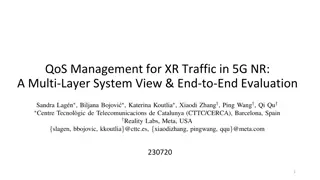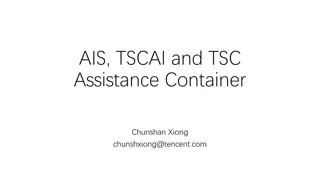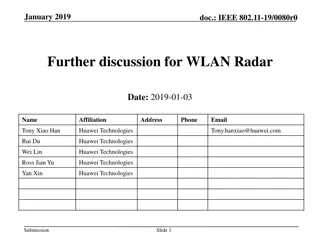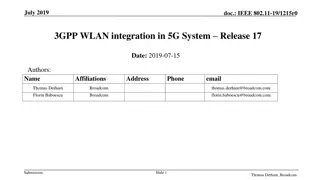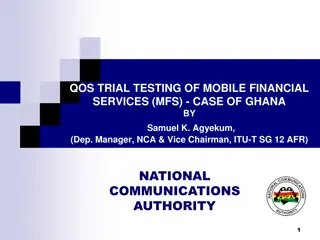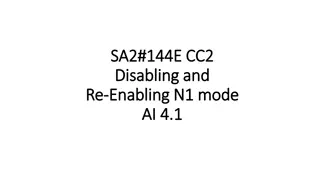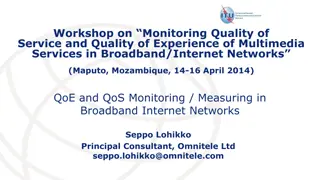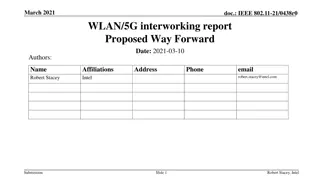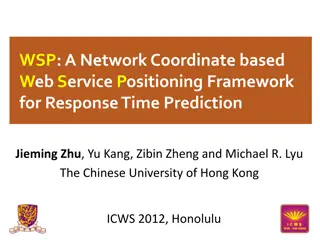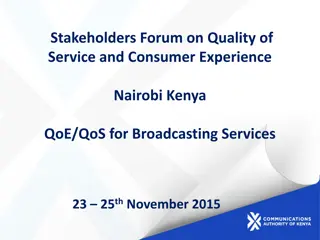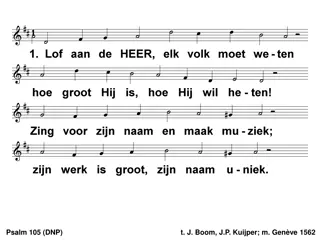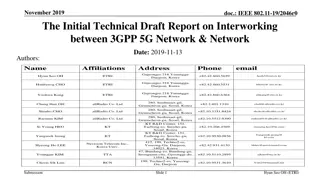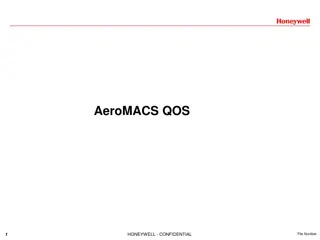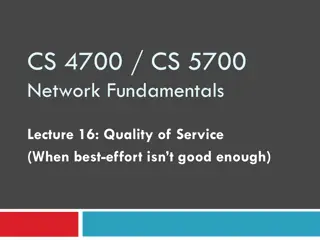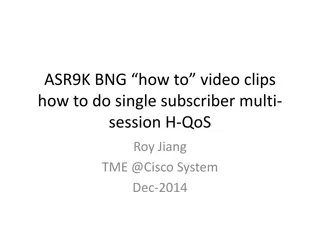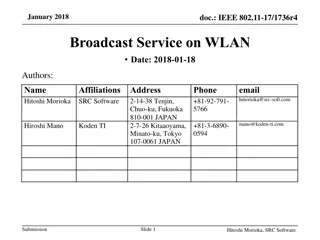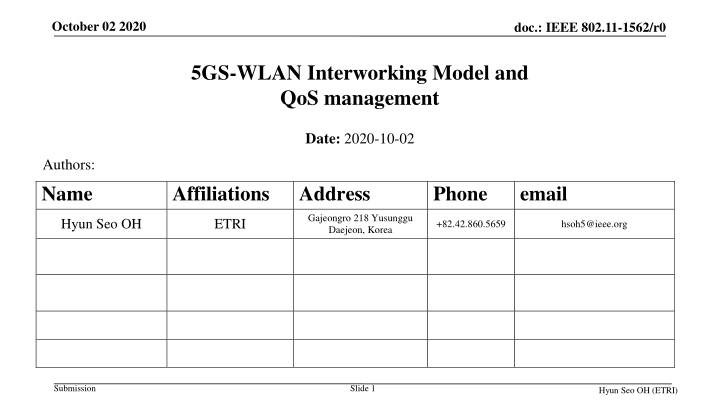
IEEE 802.11 WLAN Interworking Model for 5G QoS Management
This document discusses the interworking model between IEEE 802.11 WLAN and 3GPP 5G systems to enhance data throughput and manage Quality of Service (QoS) for different traffic types. It covers tightly coupled and loosely coupled interworking types, functional models in 5G systems, and Traffic Selection, Switching, and Splitting (ATSSS) for both GBR and Non-GBR traffic. The document also outlines the QoS flows, interfaces, and reference models for effective integration and performance in heterogeneous network environments.
Download Presentation

Please find below an Image/Link to download the presentation.
The content on the website is provided AS IS for your information and personal use only. It may not be sold, licensed, or shared on other websites without obtaining consent from the author. If you encounter any issues during the download, it is possible that the publisher has removed the file from their server.
You are allowed to download the files provided on this website for personal or commercial use, subject to the condition that they are used lawfully. All files are the property of their respective owners.
The content on the website is provided AS IS for your information and personal use only. It may not be sold, licensed, or shared on other websites without obtaining consent from the author.
E N D
Presentation Transcript
October 02 2020 doc.: IEEE 802.11-1562/r0 5GS-WLAN Interworking Model and QoS management Date: 2020-10-02 Authors: Name Affiliations Address Phone email Gajeongro 218 Yusunggu Daejeon, Korea Hyun Seo OH ETRI +82.42.860.5659 hsoh5@ieee.org Submission Slide 1 Hyun Seo OH (ETRI)
doc.: IEEE 802.11-1562/r0 Abstract It is expected that WLAN should enhance data throughput for increasing data traffic needs, and WLAN interworking to 3GPP 5G system for QoS specific ATSSS applications. This tutorial introduces WLAN interworking model to 3GPP 5G system, QoS requirements and management for Non-GBR or GBR traffic which is referred from IEEE 802.11 AANI technical report draft technical report on interworking between 3GPP 5G network and WLAN(IEEE 802.11-20/0013r5) . ATSSS: Access Traffic Steering, Switching & Splitting GBR : Guaranteed Bit Rate. Submission Slide 2 Hyun Seo OH (ETRI)
doc.: IEEE 802.11-1562/r0 WLAN Interworking Types : Tightly coupled or Loosely coupled The tightly coupled interworking type assumes that functional entities of the terminal and the two access networks are combined together and connect to 3GPP core network thus allowing a co-located 3GPP Access Network and a WLAN Access. This type is RAN level interworking. The loosely coupled interworking type assumes that 3GPP and WLAN access networks operate independently and may be either co-located or be separate. This type is CN level Interworking and may have trusted or untrusted non-3GPP interworking. There are two type of terminals: UE and STA, STA only. Tightly coupled interworking reference model between 5G core network and WLAN(IEEE 802-11-20/0013r5) Loosely coupled interworking reference model between 5G core network and WLAN(IEEE 802-11-20/0013r5) Submission
doc.: IEEE 802.11-1562/r0 WLAN Interworking Functional Model in 5G System WLAN interworking function model consists of UE/STA terminal, 3GPP/WLAN access network and 3GPP core network. In the WLAN domain, R1 and R3 interfaces support the data flow via the PHY and MAC layers of STA and WLAN access network. In addition to the R1 and R3 interfaces, R8 and R9 control and management interfaces are considered to provide QoS mapping and MAC scheduling. Untrusted WLAN interworking reference model with 5G core network (IEEE 802-11-20/0013r5) Trusted WLAN interworking reference model with 5G core network (IEEE 802-11-20/0013r5) Submission
doc.: IEEE 802.11-1562/r0 Traffic Selection, Switching and Splitting(ATSSS) in 5G System When the traffic is distributed between 5G access network and WLAN access network, the same QoS should be supported as long as the WLAN access network can support the same QoS treatment as the 5G access network. QoS flows on GBR traffic and Non-GBR traffic are specified in 3GPP TS 23.501. GBR QoS Flow: A QoS Flow using the GBR resource type or the Delay-critical GBR resource type requiring guaranteed flow bit rate. Non-GBR QoS Flow: A QoS Flow using the Non-GBR resource type and not requiring guaranteed flow bit rate. AMF N11 SMF N7 PCF N2 N2 N4 N1 N1 MPTCP Proxy functionality MPTCP functionality 3GPP Access N3 UE N6 Data Network UPF ATSSS-LL functionality PMF Non-3GPP Access N3 Architectural reference model for ATSSS support(3GPP TS 23.501) Submission
doc.: IEEE 802.11-1562/r0 QoS Characteristics in GBR and delay critical GBR It is necessary that GBR flows are supported by the WLAN in both directions, e.g. non-AP STA to AP and AP to non-AP STA. Default Priority Level 20 40 Packet Delay Budget 100 ms 150 ms Packet Error Rate 10-2 10-3 Default Maximum Data Burst Volume Default Averaging Window 2000 ms 2000 ms Resource Type Example Services N/A N/A Conversational Voice Conversational Video (Live Streaming) GBR 30 50 ms 10-3 N/A 2000 ms Real Time Gaming, V2X messages Electricity distribution medium voltage, Process automation - monitoring Non-Conversational Video (Buffered Streaming) 50 300 ms 10-6 N/A 2000 ms 7 75 ms 10-2 N/A 2000 ms Mission Critical user plane Push To Talk voice (e.g., MCPTT) Non-Mission-Critical user plane Push To Talk voice Mission Critical Video user plane "Live" Uplink Streaming (e.g. TS 26.238 [y]) 20 15 56 100 ms 100 ms 150 ms 10-2 10-3 10-6 N/A N/A N/A 2000 ms 2000 ms 2000 ms 56 300 ms 10-4 N/A 2000 ms "Live" Uplink Streaming (e.g. TS 26.238 [y]) 56 300 ms 10-8 N/A 2000 ms "Live" Uplink Streaming (e.g. TS 26.238 [y]) 56 500 ms 10-8 N/A 2000 ms "Live" Uplink Streaming (e.g. TS 26.238 [y]) 56 500 ms 10-4 N/A 2000 ms "Live" Uplink Streaming (e.g. TS 26.238 [y]) 19 10 ms 10-4 255 bytes 2000 ms Discrete Automation (see TS 22.261 [x]) Delay Critical GBR 22 10 ms 10-4 1354 bytes 2000 ms Discrete Automation (see TS 22.261 [x]) 24 30 ms 10-5 1354 bytes 2000 ms Intelligent transport systems (see TS 22.261 [x]) 21 5 ms 10-5 255 bytes 2000 ms Electricity Distribution- high voltage (see TS 22.261 [x]) Submission
doc.: IEEE 802.11-1562/r0 3GPP QoS Model The SMF assigns QoS profile to AN in WLAN domain with QoS Flow Identification (QFI), which defines the QoS parameters for a QoS flow in the PDU session. QoS flow is then mapped to AN resources for the assigned QFI. Application /Service Layer Data packets from applications QoS rules (mapping UL packets to QoS flows and apply QoS flow marking) QoS Flow (all packets marked with the same QFI) PDRs Mapping QoS flows to AN Resources AN Resources (classify packets for QoS flow marking and other actions) PDU Session UPF UE AN QoS flow and mapping to AN resources in user plane for ATSSS support(3GPP TS 23.501) Submission
doc.: IEEE 802.11-1562/r0 WLAN QoS Mapping and Scheduling QoS mapping from 3GPP QoS to WLAN QoS is necessary Packet scheduling in STA and AP shall control MAC operation to meet required QoS AP QoS profile and STA DRB (Data Radio Bearers) contains service QoS identification and its parameters to define data rate, packet latency and PER value. QoS mapping and scheduling example of WLAN(IEEE 802-11-20/0013r5) Submission
doc.: IEEE 802.11-1562/r0 Gap analysis on GBR service Services Examples Packet Delay Budget PER Default Maximum Data Burst Volume Resource Type Gap Analysis of WLAN specification Conversational Voice 100 ms 10-2 N/A GBR . 802.11ax MAC cannot support 3GPP GBR requirements of deterministic packet latency, PER and data rate because the current EDCA is CSMA based MAC and supports only 4 service types of best effort, back ground, voice and video by controlling TXOP, AIFSN and contention window size. * HCCA relies on TSPECs, has a low level of implementation. service Conversational Video 150 ms 10-3 N/A Real Time Gaming, V2X messages 50 ms 10-3 N/A Non-Conversational Video MCPTT Non-MCPTT MC-Video "Live" Uplink Streaming 300 ms 10-6 N/A 75 ms 100 ms 100 ms 150 ms 10-2 10-2 10-3 10-6 N/A N/A N/A N/A . Enhanced MAC (802.11be) should consider QoS mapping, packet scheduling and related management procedures to support GBR. And PHY and MAC should be improved to control packet latency and reliability. "Live" Uplink Streaming 300 ms 10-4 N/A "Live" Uplink Streaming 300 ms 10-8 N/A "Live" Uplink Streaming 500 ms 10-8 N/A . QoS flow identification and service priority shall be mapped to have fine granularity of QoS parameters. "Live" Uplink Streaming 500 ms 10-4 N/A service types and Submission
doc.: IEEE 802.11-1562/r0 Gap analysis on Delay Critical GBR service Default Maximum Data Burst Volume Resource Type Services Examples Packet Delay Budget PER Gap Analysis of WLAN specification Delay Critical GBR Discrete Automation 10 ms 10-4 255 bytes . 802.11ax MAC cannot guarantee 3GPP delay critical GBR service requirements of latency, PER and guaranteed data rate. Discrete Automation 10 ms 10-4 1354 bytes Intelligent transport systems 30 ms 10-5 1354 bytes Electricity Distribution- high voltage 5 ms 10-5 255 bytes . Enhanced MAC (802.11be) should consider QoS mapping, packet scheduling management procedures to support GBR. And PHY and MAC should be improved to control packet latency and reliability. and related . 802.11bd NGV should consider ITS service requirement. WLAN shall support fine granularity of QoS and priority because 5G QoS ID has 6 bits and specifies QoS parameters involving GBR (Guaranteed Bit Rate), latency and PER. Packet scheduling in STA and AP shall control MAC operation to meet required QoS. AP QoS profile and STA DRB (Data Radio Bearers) contains service QoS identification and its parameters Submission
doc.: IEEE 802.11-1562/r0 5GS-WLAN Interworking Considerations From 5GS and WLAN interworking reference model s view, IEEE 802.11 should consider adding new functional entities and signaling procedures to support interworking with the 3GPP 5G network in terms of active scanning facility, association and authentication, QoS facility. QoS Management is essential ! QoS mapping to WLAN is necessary to support more granularity of QoS ID and parameters. Packet scheduling in the STA and AP should meet data rate, latency and PER. Timing scheduling and the adoption of a Hybrid ARQ scheme are very important. 802.11ax, as implemented, cannot support 3GPP GBR and delay critical GBR, and improved version (11be EHT, 11bd NGV) should consider MAC enhancement to support the service requirements. Time Sensitive Network(TSN) application is highly related to QoS management in WLAN domain. Submission

